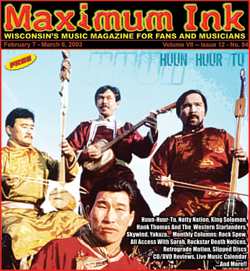Huun Huur Tu
by Andrew Frey
February 2003

Tuvan throat singers to wander through Midwest. ...What did that say? Tuvan what? What’s a Tuvan? Throat Singing? What the heck is that? All very good questions, and certainly the place to start.
The quiet country of Tuva is small Russian Republic situated at the geographical center of Asia, about 2,500 miles east of Moscow, and north of Mongolia. It is isolated both physically and culturally by surrounding mountains and it’s nomadic inhabitants are largely comprised of animal herders. The entire country is sparsely populated by about three hundred thousand people. If you or someone in your family was a stamp collector, they may have also heard of Tannu Tuva stamps. Tuva was famous for its exotic stamps and is a part of postal history. There’s always some for sale on Ebay.
Throat Singing is an ancient vocal technique called khoomei in which a single vocalist simultaneously produces two or more notes using vocal harmonics. Perhaps you saw Ghengis Blues, an award winning documentary about blind San Fransico blues musician Paul Pena and his journey to and through Tuva. He ultimately competes in the trienial khoomei championship contest. This movie caused much interest in Tuva and in throat singing in general.
Huun-Huur-Tu is one of the most famous Tuvan musical exports. According to the web site HUUN-HUUR-TU literally means “sun propeller” - the vertical separation of light rays that often occurs just after sunrise or just before sunset. For HUUN-HUUR-TU, the refraction of light that produces these rays seems analogous to the refraction of sound that produces articulated harmonics in Tuvan throat-singing.
Formed in 1992 with a goal of sharing Tuva’s remarkable musical culture with the world, HHT is currently composed of four expert throat singers, Kaigal-ool Khovalyg, Sayan Bapa, Anatoli Kuular, and Alexei Saryglar.
Kaigal-ool Khovalyg is a self-taught overtone singer, and at age of 21, he traded in his shepherds staff and settled in Kyzyl where started teaching throat singing and igil. A co-founder of Huun-Huur-Tu, Khovalyg is particularly known for his unique rendition of the khöömei and kargyraa singing styles. Sayan Bapa is also a co-founder of H-H-T. He performs on the doshpuluur, igil and acoustic guitar. As a vocalist he is currently specializing in the kargyraa style. Anatoli Kuular joined H-H-T in 1993 to replace Albert Kuvezin. An accomplished tenor vocalist, Kuular’s instrumental expertise focuses on the byzaanchi and mouth harp and vocally he excels in the borbangnadyr style. Alexei Saryglar, joined the ensemble in 1995 to replace Alexander Bapa. A multi-talented performer, Saryglar makes his mark as a sygyt singer, and is an expert with traditional Tuvan percussion and string instruments. Like the other members of the ensemble, he resides in Kyzyl when not on tour.
Their most recent CD was released in Greece in 2002. Titled “Spirits form Tuva,” interestingly enough it is a REMIX album. DJ´s from Russia, France, Greece, and Germany have taken 11 H-H-T titles and remixed with at least as many different styles. One title in particular, “Eki Attar” shot up to pop charts to #1 and was the early summer hit in Greece in 2002. H-H-T has a wide-open attitude towards the remix culture and the linking of pop music with musical tradition.
The international nomads certainly turn up in some unique places, but not very often, so don’t miss your chance to see them. For more information see the band’s web site at www.huunhuurtu.com
(7068) Page Views Huun Huur Tu Online:• Purchase on Amazon
• Download on Amazon